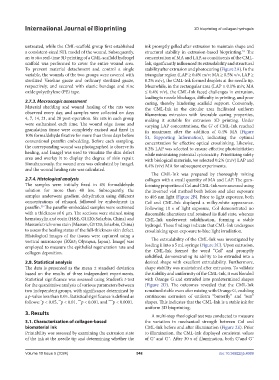Page 556 - IJB-10-5
P. 556
International Journal of Bioprinting 3D bioprinting of collagen hydrogels
untreated, while the CML-scaffold group first established ink promptly gelled after extrusion to maintain shape and
a consistent-sized STL model of the wound. Subsequently, structural stability in extrusion-based bioprinting. The
51
an in situ real-time 3D printing of a CML-scaffold hydrogel concentration of MA and LAP, as constituents of the CML-
scaffold was performed to cover the entire wound area. Ink, significantly influenced its extrudability and structural
To prevent material detachment and control a single stability after extrusion and photocuring (Figure 2A). In the
variable, the wounds of the two groups were covered with triangular region (LAP ≥ 0.4% m/v; MA ≥ 0.5% v/v, LAP ≥
sterilized Vaseline gauze and ordinary sterilized gauze, 0.2% m/v), the CML-Ink formed droplets at the needle tip.
respectively, and secured with elastic bandage and zinc Meanwhile, in the rectangular area (LAP ≤ 0.1% m/v, MA
oxide polyethylene (PE) tape. ≤ 0.4% v/v), the CML-Ink faced challenges in extrusion,
leading to nozzle blockages, difficulty in printing, and poor
2.7.3. Macroscopic assessment curing, thereby hindering scaffold support. Conversely,
Material shedding and wound healing of the rats were the CML-Ink in the circular area facilitated uniform
observed every day, and samples were collected on days filamentous extrusion with favorable curing properties,
4, 7, 14, 21, and 28 post-operation. Six rats in each group making it suitable for extrusion 3D printing. Under
were euthanized each time. The wound edge tissue and varying LAP concentrations, the Gʹ of CML-Ink reached
granulation tissue were completely excised and fixed in its maximum after the addition of 0.4% MA (Figure
10% formaldehyde fixative for more than three days before S1, Supporting Information), indicating the optimal
conventional paraffin embedding. Before each sampling, concentration for effective optical crosslinking. Likewise,
the corresponding wound was photographed to observe its 0.2% LAP was selected to ensure effective photoinitiation
healing, and ImageJ was used to visualize the skin defect while minimizing potential cytotoxicity. Prioritizing safety
area and overlay it to display the degree of skin repair. with biological materials, we selected 0.2% (m/v) LAP and
Simultaneously, the wound area was calculated by ImageJ, 0.4% (v/v) MA for subsequent experiments.
and the wound healing rate was calculated.
The CML-Ink was prepared by thoroughly mixing
2.7.4. Histological analysis collagen with a small quantity of MA and LAP. The gum-
The samples were initially fixed in 4% formaldehyde forming properties of Col and CML-Ink were assessed using
solution for more than 48 hrs. Subsequently, the the inverted vial method both before and after exposure
samples underwent gradient dehydration using different to 405 nm light (Figure 2B). Prior to light exposure, both
concentrations of ethanol, followed by embedment in Col and CML-Ink displayed a milky-white appearance.
paraffin. The paraffin-embedded samples were sectioned Following 10 s of light exposure, Col demonstrated no
50
with a thickness of 6 μm. The sections were stained using discernible alterations and retained its fluid state, whereas
hematoxylin and eosin (H&E, G1120; Solarbio, China) and CML-Ink underwent solidification, forming a stable
Masson’s trichrome stain (Masson, G1120; Solarbio, China) hydrogel. These findings indicate that CML-Ink undergoes
to assess the healing status of the full-thickness skin defect. crosslinking upon exposure to blue light irradiation.
Histological images of the tissues were captured using a
vertical microscope (BX63; Olympus, Japan). ImageJ was The extrudability of the CML-Ink was investigated by
employed to measure the epithelial regeneration rate and loading it into a 5 mL syringe (Figure 2C). Upon extrusion,
collagen deposition. the CML-Ink formed the word “Col” and promptly
solidified, demonstrating its ability to be extruded into a
2.8. Statistical analysis desired shape with excellent extrudability. Furthermore,
The data is presented as the mean ± standard deviation shape stability was maintained after extrusion. To validate
based on the results of three independent experiments. the stability and uniformity of the CML-Ink, it was blended
Statistical significance was assessed using Student’s t-test with Orange G and extruded into predetermined shapes
for the quantitative analysis of various parameters between (Figure 2D). The outcomes revealed that the CML-Ink
two independent groups, with significance determined by remained stable even after mixing with Orange G, enabling
a p-value less than 0.05. Statistical significance is defined as continuous extrusion of uniform “butterfly” and “sun”
follows: p < 0.05, p < 0.01, p < 0.001, and p < 0.0001. shapes. This indicates that the CML-Ink is a stable ink for
**
***
*
****
uniform 3D bioprinting.
3. Results A multi-step rheological test was conducted to measure
3.1. Characterization of collagen-based the variation in mechanical strength between Col and
biomaterial ink CML-Ink before and after illumination (Figure 2E). Prior
Printability was assessed by examining the extrusion state to illumination, the CML-Ink displayed consistent values
of the ink at the needle tip and determining whether the of Gʹ and G˝. After 30 s of illumination, both Gʹand G˝
Volume 10 Issue 5 (2024) 548 doi: 10.36922/ijb.4069

